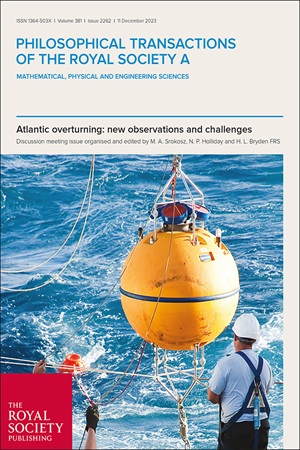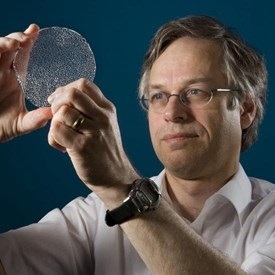Guest Editor, Professor Meric Srokosz, introduces us to his Philosophical Transactions A theme issue which explores the future projections of the Atlantic meridional overturning circulation (AMOC).

The Atlantic meridional overturning circulation (AMOC) is projected to slowdown or stop under global warming, with major climatic impacts. To determine the likelihood of this happening and understand its present state requires observations of the AMOC, which have only been available since 2004. Despite recent suggestions that the shutdown will happen soon, the observations suggest a more complex picture of the AMOC behaviour and point to the need to continue observing to improve future projections and to provide robust advice to policy makers.
Professor Meric Srokosz, Guest Editor of the Philosophical Transactions A theme issue, 'Atlantic overturning: new observations and challenges', tells us more about new observations of the AMOC.
Tell us about the idea behind this theme issue and how it came about.
The idea for this theme issue goes back to 2003 when the Royal Society hosted a meeting on Abrupt Climate Change. That meeting, and the subsequent Philosophical Transactions A theme issue, emphasised the importance of the role of the Atlantic overturning circulation in past, present and future climates. This circulation transports large amounts of heat northwards, affecting the weather and climate of the regions surrounding the Atlantic and beyond, and could potentially change quite rapidly over as short a period as a decade. At that time however, no consistent long-term measurements of the Atlantic meridional (i.e. north-south) overturning circulation (AMOC) were being made. Continuous measurements of the AMOC began in April 2004 with a trans-basin observing system at 26ËšN in the Atlantic subtropical gyre. The success of those measurements led to other AMOC observing systems being deployed both further north, in the subpolar gyre, and also in the South Atlantic. After 18 years of measurements (2004-2022 and on-going) it seemed an appropriate time to review what has been learnt and what the research challenges might be going forward. In some ways the observations could be regarded as having “come of age” and perhaps ready to transition to their next phase.
What do you think is the most exciting idea discussed in the papers?
It seems invidious to pick out one exciting idea as there were so many presented at the meeting. Perhaps the major exciting aspect that comes across in many of the papers is how there has been a paradigm shift in our understanding of the Atlantic overturning circulation. Previously viewed as a large-scale “conveyor belt” like flow, it is now known that, for example, the overturning flow is highly variable across a range of timescales from days to years, has a significant seasonal cycle, declined initially (2004-2009) at 26ËšN and is now in a reduced state (2010-2022), varies meridionally (latitudinally), and affects freshwater, nutrient and anthropogenic carbon transports as well as heat transport. All these new insights and more came from the observations, which began in 2004 and are on-going.
How can work in this area bring together researchers from different disciplines and what have been the benefits, if any, of such collaborations?
Studying the AMOC brings together a wide range of researchers: paleoclimatologists, paleoceanographers, climate scientists, physical, chemical and biological observational oceanographers, ocean modellers, climate modellers, and atmospheric scientists. This range of disciplines is necessary in order to study the past, present and future behaviour of the AMOC and its impact on climate, and on ocean processes such as the absorption of anthropogenic CO2 from the atmosphere. The combined understanding has led to improvements in climate models, and so their future projections, informed by paleo and present day AMOC observations, and to refined observational strategies informed in turn by model studies. Additionally, links have been established between present day direct AMOC observations and those obtained from proxy paleo data, so giving a fuller picture of AMOC changes over time scales from annual, to decadal, to centennial and longer.
How was your experience of being a Guest Editor on Phil Trans A?
Enjoyable! It was also an honour to guest edit an issue of the world’s first and longest running scientific journal. To slightly misquote Isaac Newton with regard to the contributions in this issue “if we have seen further, it is by standing on shoulders of giants.” In particular, there are two “giants” to be acknowledged in this field, Henry Stommel and Wally Broecker, who pioneered the importance of the overturning circulation and its possible abrupt change. In addition, it has been a pleasure to work with my fellow Guest Editors, Professor Penny Holliday and Professor Harry Bryden, and with Alice Power at the Royal Society, in preparing this issue.

Tell us a bit about your own research.
Strange to say I have just retired (though I continue to “dabble” in research), so this is more of a reflection on my career. The Royal Society meeting and this issue are a sort of “swan song”/culmination of my career. Having started out in research as a mathematician working on wave power in the 1970s (alternative energy during the oil crisis of that period), I moved into oceanography studying breaking and rogue waves, satellite oceanography (measuring the oceans from space, working with NASA and ESA), biological-physical interactions in the upper ocean, and the ocean’s role in climate. It has been a varied and interesting research career, which I have enjoyed. A particular pleasure, with regard to research on the overturning circulation over the last 20 years, has been to see those who were initially Ph.D. students progress in their careers, with a number becoming professors more recently. This ensures that the field will continue to develop and grow, which is satisfying.
What's the biggest take-away message from the papers in the issues?
Given that the timescale of potential abrupt changes in the overturning circulation is decadal and we have only 18 years of observations to-date, the biggest take away message is the need to continue to the AMOC observations for longer. Linked to this is the challenge of finding the most effective way, both operationally and in terms of cost, to continue the observations. So far the observations have produced many new and unexpected insights into the Atlantic overturning circulation and no doubt there will be many more to come as the observations continue.
What is the future for research in this area?
The future for research in this area is exciting. As the observations continue, doubtless further new insights will emerge and in turn stimulate new research. The on-going interactions between observationalists (paleo and present day) and modelers will undoubtedly lead to improved predictions and projections of the overturning circulation and its potential for abrupt change, and consequent climate impacts. While the papers in this issue demonstrate how much progress has been made in the last 18 years and show that AMOC observations have indeed “come of age”, they also demonstrate that there is still much more to be learnt about this key element of the Earth’s climate system.
To read more content from Philosophical Transactions A, or to find out how you can become a Guest Editor for the journal, please visit our website.
-------------------------------------------------------------------
Image caption: Deploying an OSNAP AMOC observing system mooring from the RRS James Cook in the subpolar North Atlantic. Credit: Dr Ben Moat, NOC.





